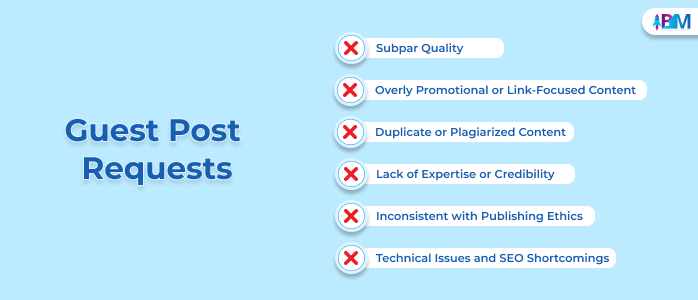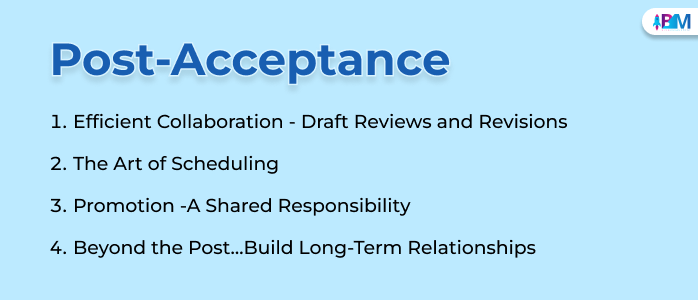“Is the guest post relevant and original?”
“Does the guest post prioritize SEO over quality?”
“Will the guest post align with our brand?”
“How much editorial resources to allocate for guest posts?”
“Are there legal risks with the guest content?”
“Will our audience engage with the guest post?”
“How to handle the monetization of guest posts?”
Relatable?
Well…well…well…
Every single day, we get at least 30 emails from our awesome readers, pouring out their concerns about guest post requests.
Can you believe it? Yes, that is true.
(Especially if you are a beginner.)
Guest posts are like gems, but not all of them are equally valuable. So, choose guest posts wisely.
After all, it’s directly correlated to your brand’s reputation.
Fear not! In this article, we’ll delve into the factors and things to consider when deciding whether to accept guest post requests.
So, before opening your platform to guest posts, let’s ensure you have all the information you need.
Table of Content
1. Why is guest posting so important?
2. First Impression
- Example of a generic guest post request.
- Example of a relevant guest post pitch.
- Comparison between the two.
3. Drafting guidelines to evaluate guest post requests better.
4. How to avoid the red flags?
5. Post acceptance efforts.
Understanding The Value Of Guest Posts

Guest posts go beyond simply filling your content calendar.
Each guest post is an opportunity to bring fresh perspectives and ideas to your audience, thus keeping your content vibrant and diverse.
This diversity engages your current audience and attracts new readers, expanding your reach.
In fact, guest posts are a powerful tool for SEO. They bring with them new sets of keywords and topics, enhancing your site’s relevance and authority in search engines.
This is crucial in an era where search engine algorithms prioritize content variety and depth. With expert voices from your industry, you’re not just adding content but also building a brand.
This knowledge repository, in turn, positions your platform as a hub for thought leadership.
As a guest poster, you will also have networking opportunities. Collaborating with other experts and influencers can expand your brand’s influence and reach. It is a mutually beneficial relationship that benefits both parties.
With this knowledge, you better understand why you should accept guest posts on your blog.
Now, understand it practically; let’s say your website has a “write for us” section, and you have received a guest post request.
Now, what next?
The First Impression – Generic vs Relevant Guest Post Request
The contrast between a generic and a relevant request (pitch) is pretty striking.
And it can greatly impact whether or not your post gets accepted and the value it could bring to your platform.
So, let’s take a look at some examples of both types of pitches and see why a relevant pitch stands out.
Example Of A Generic Guest Post Pitch
Subject: Guest Post Submission for Your Blog
Dear Editor,
I am an experienced writer interested in submitting a guest post on your blog. I have written on various topics and believe I can contribute valuable content to your site.
Please let me know if you have any openings for guest posts and the topics, you’re interested in.
Best regards,
[Name]
Analysis
This pitch is quite vague. It lacks specificity about the writer’s expertise or what they can offer. The blog’s content focus or audience is not mentioned, indicating a one-size-fits-all approach. It doesn’t make a compelling case for why you should consider their contribution.
Example Of A Relevant Guest Post Pitch
Subject: Tailored Guest Post on [Your Blog’s Specific Niche]
Dear [Name of the recipient],
I recently read your article on [Specific Topic] and found it incredibly insightful.
As a [Their Expertise], I’ve been exploring [Specific Aspect of Your Blog’s Niche] and have compiled unique insights and strategies that I believe would greatly interest your readers.
I would love the opportunity to contribute a guest post titled “[Proposed Post Title],” which delves into [Brief Description of the Content].
I’ve noticed you haven’t covered this specific angle, and I think it could add great value to your blog.
Looking forward to the possibility of collaborating with you.
Warm regards,
[Name]
Analysis
This pitch immediately stands out. It shows the writer has done their homework, understood your blog’s niche, and referenced a specific article, indicating genuine engagement with your content.
The proposed topic is relevant and adds a new dimension to your existing content. This level of specificity and relevance demonstrates the writer’s commitment and the potential value they could bring to your audience.
Comparison: What’s Special About Relevant Guest Post Pitch?
Well, let’s get straight to the point. The generic pitch lacks personalization.
It could be sent to any number of blogs, making it less likely to align well with your specific content strategy.
On the other hand, the relevant pitch shows a clear understanding of your content and audience. It suggests a unique angle that could benefit your readers, indicating that the writer will likely produce a post of value.
This tailored approach not only makes a strong first impression but also promises a post that could enhance your content’s depth and diversity.
Red Flags To Avoid While Handling Guest Post Requests

You can save your blog’s integrity and quality early by spotting the red flags.
Here are the signs a guest post request might be more trouble than it’s worth.
❌Subpar Quality
Quality is non-negotiable. Right? A guest post riddled with grammatical errors, poor structure, or superficial content dilutes your blog’s credibility. High-quality content is the cornerstone of your platform, and any submission that falls short of this standard undermines your reputation.
❌Overly Promotional or Link-Focused Content
If the post feels like an advertisement or has too many irrelevant backlinks, simply decline it. Because guest posts should provide value to your readers.
❌Duplicate Or Plagiarized Content
Originality is key. A submission that is a rehash of existing content, or worse, plagiarized, is a serious concern. Not only does it reflect poorly on your brand, but it also invites potential legal issues.
❌Lack Of Expertise Or Credibility
Guest posts should come from authors with a certain level of expertise or credibility in their field. If the author lacks the experience or knowledge to provide insightful and authoritative content, their post is unlikely to add value to your audience.
❌Inconsistent With Publishing Ethics
Any content that pushes unethical practices, makes unsupported claims, or is in any way controversial in a harmful way should be rejected. It’s essential to uphold a standard of integrity in what you publish.
❌Technical Issues And SEO Shortcomings
If a post is not SEO-friendly, lacks appropriate keyword usage, or has technical shortcomings that make it unsuitable for online publishing, it’s better to decline. SEO is a crucial component of digital content; guest posts should align with these requirements.
Have you understood what to avoid? Well, knowing the red flags is half the job done. You must ensure you don’t repeat these mistakes. And that is where guidelines come into the picture.
Draft Guidelines To Better Evaluate Guest Post Requests
As a publisher who values high-quality content, setting up clear guidelines is essential.
Here’s how to outline your criteria:
✅First comes Checking the Site’s DA and DR. This helps to understand the quality and reputation of their website in the digital space.
✅Next, author credibility. Prioritize authors with expertise and a solid reputation in your niche. Evaluate their previous work to gauge their knowledge and writing ability. This ensures that the content will be authoritative and credible.
✅Thirdly, the guest post should match the tone and style of your blog. Whether it’s professional, conversational, or informative, maintaining this consistency is key.
✅Also, focus on anchor text and linking. Links should be relevant, add value to the content, and not appear promotional or spammy. Set guidelines on the number and type of links allowed.
✅High writing standards are non-negotiable. The content should be well-structured, grammatically correct, and free of jargon. It should flow naturally and be easy to read, holding the reader’s attention from start to finish.
✅Specify a minimum word count to encourage in-depth coverage of the topic. However, the focus should be on the quality and comprehensiveness of the content, not just on meeting a mere word count.
💡Bonus Tip: Check for the author’s previous work. Ask for samples of the author’s previous work. This helps assess their writing style and the quality of content they produce. It also gives an insight into their expertise and credibility in the subject matter.
Post-Acceptance

In managing the guest post workflow post-acceptance, efficiency and communication are crucial.
The journey from a mere draft to a published piece involves several key steps. Each of these steps requires meticulous attention to detail and proactive collaboration.
1. Efficient Collaboration – Draft Reviews And Revisions
The initial draft review is more than just a cursory glance; it’s a deep dive into ensuring that the content aligns with your brand’s voice, audience’s interests, and quality standards. Providing constructive feedback is crucial – a balance of what works and what needs improvement.
Encourage guest authors to view revisions as a collaborative process, a shared journey toward excellence. Clear, specific feedback streamlines the revision process and elevates the final output.
2. The Art Of Scheduling
Timing is everything in content publishing. Integrating the guest post into your content calendar requires strategic planning. It’s not just about slotting in a post; it’s about determining when the piece will have the maximum impact.
Consider factors like topical relevance – is there an industry event or trend that aligns with the post? Or audience engagement patterns – when is your audience most active? The right timing can significantly amplify the post’s reach and engagement.
3. Promotion -A Shared Responsibility
Promoting a guest post is a joint effort. While your platforms offer a stage, encouraging guest authors to share the post in their networks can exponentially increase its visibility.
Leverage social media, newsletters, and other marketing channels to give the post the spotlight it deserves.
Remember, effective promotion is not a one-off effort; it’s a sustained campaign to ensure continued engagement.
4. Beyond The Post…Build Long-Term Relationships
Finally, the end of the post-publication process marks the beginning of a potential long-term relationship.
Guest authors are not just one-time contributors; they can be valuable allies in your content journey.
Foster these relationships by staying in touch, offering feedback, and exploring future collaboration opportunities.
The End Note
Now that you have all the necessary information, you can assess the quality of guest post requests.
However, it is a time-consuming process because it requires attention to detail.
What if we told you that…
…you could get guest posts that have been quality-checked?
Plus, whenever you publish an article, it will be 100% original and SEO-optimized.
AND.
You will be getting paid to publish content on your site. Amazing! Isn’t it?
Well, we are talking about our platform, Blog Management!
Creating an account with us only takes a few minutes, and listing your site. Usually, the top publishers get 20-30 orders (minimum) every month. That is around 3000 dollars.
If you want some extra dollars (who doesn’t want?), sign up with Blog Management.
Read Also:
